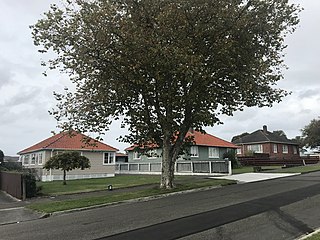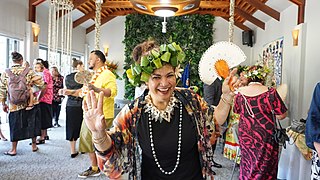Related Research Articles

The demographics of New Zealand encompass the gender, ethnic, religious, geographic, and economic backgrounds of the 5.1 million people living in New Zealand. New Zealanders predominantly live in urban areas on the North Island. The five largest cities are Auckland, Wellington, Christchurch, Hamilton, and Tauranga. Few New Zealanders live on New Zealand's smaller islands. Waiheke Island is easily the most populated smaller island with 9,390 residents, while Great Barrier Island, the Chatham and Pitt Islands, and Stewart Island each have populations below 1,000. New Zealand is part of a realm and most people born in the realm's external territories of Tokelau, the Ross Dependency, the Cook Islands and Niue are entitled to New Zealand passports.

Lieutenant-General Bernard Cyril Freyberg, 1st Baron Freyberg, was a British-born New Zealand soldier and Victoria Cross recipient, who served as the 7th Governor-General of New Zealand from 1946 to 1952.

The Northland Region is the northernmost of New Zealand's 16 local government regions. New Zealanders sometimes refer to it as the Winterless North because of its mild climate all throughout the year. The main population centre is the city of Whangārei, and the largest town is Kerikeri. At the 2018 New Zealand census, Northland recorded a population growth spurt of 18.1% since the previous 2013 census, placing it as the fastest growing region in New Zealand, ahead of other strong growth regions such as the Bay of Plenty and Waikato.

The 2nd New Zealand Division, initially the New Zealand Division, was an infantry division of the New Zealand Military Forces during the Second World War. The division was commanded for most of its existence by Lieutenant-General Bernard C. Freyberg. It fought in Greece, Crete, the Western Desert and Italy. In the Western Desert Campaign, the division played a prominent role in the defeat of German and Italian forces in the Second Battle of El Alamein and the British Eighth Army's advance to Tunisia.

The New Zealand Census of Population and Dwellings is a national population and housing census conducted by government department Statistics New Zealand every five years. There have been 34 censuses since 1851. In addition to providing detailed information about national demographics, the results of the census play an important part in the calculation of resource allocation to local service providers.

Kawhia Harbour is one of three large natural inlets in the Tasman Sea coast of the Waikato region of New Zealand's North Island. It is located to the south of Raglan Harbour, Ruapuke and Aotea Harbour, 40 kilometres southwest of Hamilton. Kawhia is part of the Ōtorohanga District Council and is in the King Country. It has a high-tide area of 68 km2 (26 sq mi) and a low-tide area of 18 km2 (6.9 sq mi). Te Motu Island is located in the harbour.

Oriental Bay is a bay and suburb of Wellington, the capital city of New Zealand. Noted for being both a popular beach and a luxurious centre of affluence in the city, it is located close to the Central Business District on Wellington Harbour.

Browns Bay is one of the most northernmost suburbs in the contiguous Auckland metropolitan area, located in the North Shore. It is located in the East Coast Bays area, a string of small suburbs that form the northernmost part of the North Shore of Auckland.

Te Atatū South is a residential suburb in West Auckland, New Zealand. Its location allows the suburb easy access to the city and Henderson town centre. Its elevation allows views back on to the city and Waitākere Ranges. Situated on the Te Atatū Peninsula, it has coasts backing on to water on its eastern and western sides with walkways and cycleways on both sides.
European New Zealanders, also known by the Māori-language loanword Pākehā, are New Zealanders of European descent. Most European New Zealanders are of British and Irish ancestry, with significantly smaller percentages of other European ancestries such as Germans, Poles, French, Dutch, Croats and other South Slavs, Greeks, and Scandinavians.

Freyberg High School is a state co-educational secondary school located in the suburb of Roslyn in Palmerston North, New Zealand.

Roslyn is a suburb in the city of Palmerston North, Manawatū-Whanganui, New Zealand.
Indian New Zealanders are persons of Indian origin or descent, living in New Zealand. The term includes Indians born in New Zealand, as well as immigrants from India, Fiji, as well as other regions of Asia, parts of Africa such as South Africa as well as East Africa, and furthermore, from other parts of the world. The term Indian New Zealander applies to any New Zealanders with one or both parents of Indian heritage. Although sometimes the Indo-Kiwi definition has been expanded to people with mixed racial parentage with one Indian parent or grandparent, this can be controversial as it generally tends to remove the ethnic heritage or identity of the foreign parent or grandparent which may be termed as insensitive to those with mixed parentage, who tend to value both their Indian and non-Indian parents and grandparents.
American New Zealanders are New Zealand citizens who are of American descent of American-born citizens from the United States. American New Zealanders constitute a small minority of New Zealand's population.

The Māori are the indigenous Polynesian people of mainland New Zealand. Māori originated with settlers from East Polynesia, who arrived in New Zealand in several waves of canoe voyages between roughly 1320 and 1350. Over several centuries in isolation, these settlers developed their own distinctive culture, whose language, mythology, crafts, and performing arts evolved independently from those of other eastern Polynesian cultures. Some early Māori moved to the Chatham Islands, where their descendants became New Zealand's other indigenous Polynesian ethnic group, the Moriori.

The Auckland Region is New Zealand's most populous territorial authority and Auckland its most populous city. In the 2018 census, 1,571,718 persons declared themselves as residents of the region – an increase of 156,178 people or 11.0% since the 2013 census. The Auckland Region accounts for about one-third (33.4%) of New Zealand's population. Auckland has a large multicultural mix, including the largest Polynesian population in the world.
Asian New Zealanders are New Zealanders of Asian ancestry.
The 2018 New Zealand census was the thirty-fourth national census in New Zealand, which took place on Tuesday 6 March 2018. The population of New Zealand was counted as 4,699,755 – an increase of 457,707 (10.79%) over the 2013 census.

Pasifika New Zealanders are a pan-ethnic group of New Zealanders associated with, and descended from, the Indigenous peoples of the Pacific Islands outside of New Zealand itself. They form the fourth-largest ethnic grouping in the country, after European-descended Pākehā, Indigenous Māori, and Asian New Zealanders. There are over 380,000 Pasifika people in New Zealand, with the majority living in Auckland. 8% of the population of New Zealand identifies as being of Pacific origin.
References
- 1 2 "2018 Census ethnic group summaries | Stats NZ". www.stats.govt.nz. New Zealand government. Retrieved 9 January 2023.
